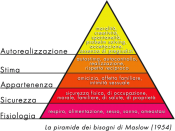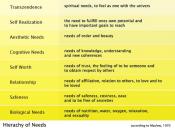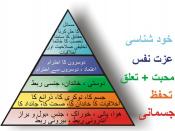Several parallels can be drawn between the psychologist Abraham Maslow's theoretical hierarchy of needs and the spiritual journey of Siddhartha, the eponymous main character in Herman Hesse's novel. Maslow's hierarchy of needs is somewhat of a pyramid that is divided into eight stages of need through which one progresses throughout one's entire life. During the course of his lifetime, Siddhartha's personality develops in a manner congruent with the stages of Maslow's hierarchy. Siddhartha's progress from each of the major sections of the hierarchy is marked by a sharp change in his life or behavior.
Siddhartha is the story of a young man's journey in search of truth. Early in life, Siddhartha and his friend Govinda hear the teachings of the Buddha. Govinda is convinced of the validity of the Buddha's teachings and becomes one of his followers. Siddhartha, on the other hand, was not satisfied with the Buddha's teachings because he believed that it was not possible to obtain true enlightenment through the words of others but that it must be experienced empirically.
Siddhartha therefore rejects the life of a Brahmin to become a Samana (a wandering person who gives up material possessions for his faith). After he tires of this life, he moves on to learn the art of love from a woman named Kamala and the art of business from a man named Kamaswami. He lives his new life for many years but then begins to feel that his mind has become stagnant and that he needs something new in his life. He abandons the surroundings he now finds decadent and becomes friends and lives with a ferry-man who he met years before. He spends the rest of his life with his friend learning about the nature of things from the river and seeking contentment.
Abraham Maslow...



Siddhartha
This was okay, but there is definitely room for improvement. I realize it was just 11th grade, but I would've liked to see closer implementation of Maslow into the story. It seems like you just mention Maslow, make a few connections and expect the reader to do the rest. Anyways, the essay flowed relatively well, although I would've liked a longer conclusion. There was a bit of contradiction at the end, stating it is not the achievments that make the journey, but you go on to say that the journey revolved around the hope for achievements. That really bothered me, and made it seem as though you missed the point entirely. Nice effort, overall, though.
2 out of 2 people found this comment useful.